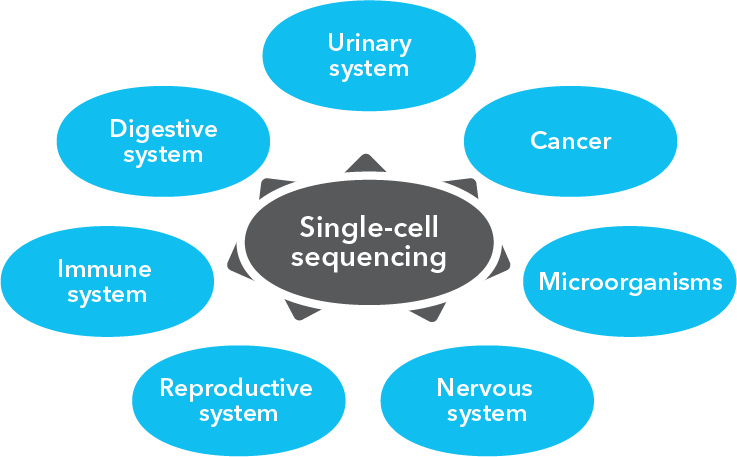By Dr. Jing Wang, Project manager, Bioinformatics, MedGenome Inc
In 2013, single-cell sequencing was selected as the method of the year to highlight its ability to sequence DNA and RNA in individual cells. The advantages of such high-resolution sequencing are to unveil previously unknown cell population heterogeneity and to perform more accurate analysis. The high degree of heterogeneity in tumor tissue is widely considered to relate to the mechanisms of tumorigenesis and metastasis. Traditional sequencing methods can only detect cell populations then get the average of the signals in a group of cells. Now with the help of single-cell sequencing and analysis, researchers can explore the heterogeneity among individual cells, detect rare cell types, study immune process and do much more (Figure 1).

The single-cell techniques are improving dramatically since then together with the emerging next generation sequencing platforms. Commercially available single-cell kits such as inDrops, 10X Genomics, Drop-seq and SMART-seq utilize two major methods to reach single-cell resolution, droplet encapsulation and plate-based isolation. More and more applications of single-cell sequencing have invaded the market including transcriptome sequencing, TCR/BCR sequencing, ATAG-seq and even spatial gene expression. At MedGenome US research group, we offer various levels of analysis for single-cell applications. We can perform the standard Cell Ranger analysis utilizing our intensive computing resources or AWS. The analysis results include gene expression matrix for transcriptome sequencing, clonotypes for TCR/BCR sequencing and more. Further downstream analyses such as cell type assignment, clonal expansion study is also offered with sophisticated pipelines developed in house.
Along with these individual applications, multi-modal analyses are another big trend in the field of single-cell. In 2019, single-cell multi-modal omics was selected as the method of the year. It is the ability to make the most of your samples and to measure multiple data types simultaneously from the same cell. The common multi-modal applications include antibody tagging CITE-seq, overlaying transcriptome sequencing with TCR/BCR and overlaying transcriptome sequencing with ATAG-seq. Antibody-tagging CITE-seq can help researchers understand protein level expression in a quantitative way together with transcriptome expression. It can also be used to tag multiple samples together into one pool and construct one library, which is more cost effective. Overlaying transcriptome sequencing with TCR/BCR allows researchers to study clonotype distribution across different cell types and to track specific clonotype abundance. Overlaying transcriptome sequencing with epigenome ATAG-seq enables researchers to gain deeper insights into gene regulation mechanisms. At MedGenome US research group, we offer customized multi-modal analyses consisiting of custom pipeline development, publication ready visualization and knowledge-based data interpretation.
More and more bioinformatics tools are being developed to fulfill complicated single-cell analysis needs. With tumor and normal single-cell transcriptome datasets, people can utilize tools such as InferCNV to understand CNVs. Complex cell communications can also be characterized using tools like CellPhoneDB, which predicts communicating pairs of cells. With the help and unique advantage of single-cell sequencing technique, we believe the studies in various biology fields become easier and more accurate.
References
- Tang et al., The single-cell sequencing: new developments and medical applications. Cell Biosci 9, 53 (2019). https://doi.org/10.1186/s13578-019-0314-y
#Single Cell Analysis, #Tumor, #cell population heterogeneity, #SMART-seq, #single-cell resolution, TCR/BCR sequencing, ATAG-seq
 US
US IN
IN

